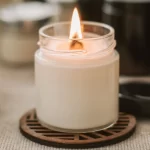Yankee Candles have long been a beloved choice for adding delightful fragrances to homes. Their wide range of scents and high-quality wax make them a popular choice. However, worries about their likely toxicity have emerged. Are Yankee Candles toxic? Let’s explore this topic in detail.
Contents
- 1 What Are Yankee Candles Made Of?
- 2 Potential Toxins in Candles
- 3 Soot and Indoor Air Quality
- 4 Fragrance Concerns
- 5 Wick Safety
- 6 Reducing Risks
- 7 Identifying Safer, Non-Toxic Candle Options
- 8 Are Certain Essential Oils in Candles Hazardous to Pets?
- 9 Reported Health Issues from Regular Candle Use
- 10 Choosing the Right Candle for You
- 11 Finale
- 12 FAQs
What Are Yankee Candles Made Of?
Yankee Candles are made of wax, oils, and wicks. Paraffin wax, derived from petroleum, has been a point of contention. Yankee Candles are made from three main components:
Wax
Yankee Candles uses paraffin wax, which is derived from petroleum. Some candles may also contain natural wax blends, including soy wax. The choice of wax affects how the candle burns and how fragrance is released.
When you light a candle, the flame heats and melts the wax around the wick, turning it from solid to liquid. This liquefied wax acts as a carrier for the fragrance oils, allowing them to evaporate and diffuse into the air as the candle burns. The more wax that melts, the more fragrance is released into your space.
Fragrance
These candles are known for their strong and long-lasting scents, a combination of natural and synthetic fragrance oils. Fragrance is added to the melted wax before it hardens. The type and amount of fragrance oil play a big role in how much scent is released and how far it travels in a room.
As the wax melts during burning, the fragrance oils trapped in the solid wax are gradually released, filling your home with scent until most of the wax is used up.
Wicks
The wicks in Yankee Candles are made from cotton or other natural fibers. The material and size of the wick decide how long the candle burns and how much fragrance is released. A properly sized wick ensures steady melting of the wax and consistent scent diffusion throughout the life of the candle.
By understanding how wax, fragrance, and wick work together, it’s easier to see why Yankee Candles are so popular and why questions about their ingredients often come up.
Potential Toxins in Candles
Paraffin wax, a common ingredient in many candles, has been at the center of the debate over its toxicity. When candles burn, they release volatile organic compounds (VOCs) such as toluene and benzene.
These chemicals are also found in diesel fuel fumes and may cause health issues like respiratory problems and headaches. However, the levels of (volatile organic compounds) VOCs released by burning paraffin candles in a typical home environment are generally low and within safety standards.
Soot and Indoor Air Quality
Another concern with paraffin wax is the production of soot, tiny black carbon particles that result from incomplete combustion. Soot can fix on walls, furnishings, and even air vents, contributing to indoor air pollution. According to the US Environmental Protection Agency (EPA), indoor air can sometimes be more polluted than outdoor air, and burning paraffin candles adds to this issue.
Soot isn’t just messy; it’s a type of particle pollution that can exacerbate respiratory and cardiovascular conditions, especially in individuals with sensitive health conditions. Clogged chimneys and poor ventilation caused by soot buildup can also pose a fire hazard if not properly managed. While the overall risk remains low with moderate candle use and good ventilation, it’s wise to be mindful of these factors, particularly if anyone in your home has asthma or allergies.
Fragrance Concerns
The fragrances used in Yankee Candles can also be a source of concern. Synthetic fragrance compounds can sometimes cause allergic reactions or sensitivities. Common symptoms include headaches, respiratory irritation, or skin reactions. Also, Yankee Candle does offer a range of unscented options for those who prefer them.
Wick Safety
The wicks used in Yankee Candles are generally safe, as they do not contain lead. Lead-core wicks were banned in the United States in 2003 due to their potential health hazards. Yankee Candle ensures wicks are made from safe materials, such as cotton.
Reducing Risks
If you’re concerned about the potential risks associated with burning candles, here are some tips to minimize any harm:
- Ventilation: Consistently burn candles in a well-ventilated spot to disperse VOCs or fragrance particles.
- Moderation: Limit the amount of time you burn candles. Enjoy them for a few hours rather than all day.
- Trim Wicks: Keep the candle wicks trimmed to about 1/4 inch to prevent excessive soot and smoke.
- Choose Alternatives
Consider using battery-operated candles or essential oil diffusers for a flame-free way to enjoy pleasant scents.
Identifying Safer, Non-Toxic Candle Options
With ingredient transparency not always guaranteed, choosing a safer candle can feel like detective work. Here are a few practical steps to make the process easier:
- Read Labels Closely: Look for candles labeled as made with 100% natural waxes, such as soy, coconut, or beeswax. These options generally produce fewer chemicals when burned compared to paraffin varieties.
- Opt for Essential Oils: Candles scented with pure essential oils tend to be gentler than those made with synthetic fragrance oils. Still, always check for ingredient lists; some essential oils can be irritating, and certain oils may not be safe for pets.
- Choose Unscented When Sensitive: If you or your family are sensitive to fragrances, unscented candles made from natural wax are usually the safest bet. Beeswax candles, for example, offer a faint honey scent without added fragrance.
- Consider Flameless Alternatives: Wax warmers, candle warmers, and flameless LED or battery-operated candles are great for enjoying ambiance and scents without introducing smoke or soot into your indoor air.
- Request Ingredient Information: Don’t hesitate to reach out to brands for more details if labels are vague. Companies that prioritize transparency should be able to provide a complete list of ingredients.
- Look for Third-Party Certifications: Some candles carry certifications like “non-toxic” or “clean-burning,” awarded by organizations such as Green Seal or the National Candle Association. While not foolproof, such labels can be reassuring.
Knowing your options and taking a few extra minutes to do a little research can help ensure you’re bringing home candles that align with your health and comfort preferences.
Are Certain Essential Oils in Candles Hazardous to Pets?
Pet owners often wonder if the pleasant aroma from candles could spell trouble for their furry companions. The answer depends largely on the specific essential oils used in the candle’s fragrance blend. While many scents are perfectly safe, some essential oils commonly found in candles, such as tea tree, peppermint, wintergreen, pine, and eucalyptus. Even lavender can cause health threats to pets, especially cats and dogs.
Some pets may experience symptoms like drooling, difficulty breathing, lethargy, vomiting, or skin irritation if exposed to these oils, either through inhalation or accidental ingestion. Animals with asthma or respiratory sensitivities are especially at risk and may need to avoid scented candles altogether.
To keep your household safe:
- Check candle ingredient labels for essential oils that are known to cause issues.
- If your pet starts acting strangely or seems unwell after you light a candle, extinguish all flames promptly and consult your veterinarian.
- When in doubt, opt for unscented candles or those with simple, natural ingredients and ensure your burning area is well-ventilated.
- Taking these steps lets you enjoy the warm ambiance of a candle—without putting your four-legged family members at risk.
Reported Health Issues from Regular Candle Use
Frequent use of scented candles has sometimes been linked to certain health complaints. Studies have shown that some people experience symptoms such as headaches, difficulty breathing, and coughing after repeated exposure. These effects tend to be more common in individuals who are sensitive to fragrances or have underlying respiratory conditions. For most healthy adults, casual candle burning seldom leads to lasting problems, but it’s important to be mindful of any discomfort or reactions you notice.
Choosing the Right Candle for You
Ultimately, the best candle choice depends on your preferences and sensitivities. If you love Yankee Candles, there’s no need to discard them. Also, ensure you burn them responsibly. On the other hand, if you’re concerned about potential toxins, natural wax candles might provide peace of mind.
Finale
Yankee Candles offers a delightful way to enhance your home’s ambiance. While the question of whether Candles are harmful doesn’t have a simple yes or no answer, the overall agreement is that they are generally safe for occasional use. If you have specific health concerns or sensitivities, you might want to explore alternative options that better suit your needs.
FAQs
Do Yankee Candles have toxins?
Yankee Candles can emit volatile organic compounds (VOCs) when burned, primarily due to paraffin wax.
What are the least toxic candles?
Soy and beeswax candles are the least toxic candles. Soy candles are purer and longer burning than paraffin candles. Also, beeswax candles are natural, burn slowly, and purify the air with negative ions.
What is the Yankee Candle controversy?
The controversy is that they use paraffin wax and synthetic fragrances, which can release harmful chemicals.
- Sell Your Candles At Markets: A Complete Guide - August 11, 2025
- How to Start a Candle Business in 2025 (From $200 to Profitable) - August 1, 2025
- How to Price Candles in 2025? (In 9 Easy Steps) - July 3, 2025







